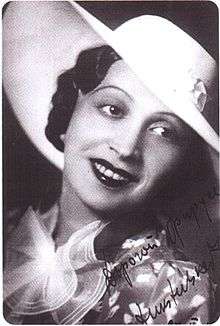Nadezhda Dukstulskaite
Nadezhda Dukstulskaite [alternative spelling Nadežda Dukstulskaitė; surname also written Dukshtulsky or Dukstulsky][1] (5 March 1912 – 2 October 1978)[2] was a pianist whose concerts and recordings promoted international awareness of Lithuanian composers, and who influenced several generations of Lithuanian pianists, singers and other musicians.[3] She was one of the few survivors of the Kovno Ghetto.[4]
Early life

Nadezhda Dukstulskaite was born in a Jewish family of musicians in what was then Dvinsk, part of the Russian Empire but is now the Latvian city of Daugavpils. Her talent manifested itself very early, during piano studies under her father, Martynas Dukstulskis, from age five, and from age seven at a private piano school in the Lithuanian city of Kaunas, where the family moved in 1918.[5] At age 12 she was admitted to the Stern Conservatory in Berlin, where she studied for six years under the influential piano teacher Leonid Kreutzer, graduating in 1928.[6] Shortly after returning to Kaunas, her father died unexpectedly. To support the family, she took a job playing piano at a cinema.[7]
Career to 1941
From 1929 to 1941 her work in radio as well as concerts that she gave throughout Northern Europe (including many Lithuanian pieces in her repertoire) earned broad recognition for Lithuanian music at home and abroad.[8][9] During this period, she was part of a core group of musicians who worked at the state-run Kaunas Radio to develop Lithuania's first music programs and concert broadcasts for radio.[10]
Wartime
With the invasion of Lithuania by Nazi Germany in 1941, she was detained in the Jewish ghetto in Kaunas (the Kovno Ghetto). She participated often in the concerts of the Kovno Ghetto Orchestra. She was held there until 1944, when she escaped from a work detail and then traveled to safety in Vilnius by foot.[11]
Post-war career
Remaining after the end of World War II in Lithuania,[12] which was annexed by the Soviet Union, she in 1944 resumed her work as a radio pianist, concert pianist and accompanist, touring throughout the republics of the Soviet Union.[13] Throughout this period, which continued until 1959, she made great personal efforts to help talented young musicians develop and mature.[14]
Later life
Due to poor health, in 1959 she formally retired, but nonetheless remained active.[15] In fact, from 1959 right up until her death in 1978, she played a major role in the creation and development of the Ažuolukas choir and music school, helping many later accomplished musicians to take their first steps in music.[16]
Prominent Lithuanian musicians who have attributed their achievements in part to studies under Nadezhda Dukstulskaite include the opera singer Vladimiras Prudnikovas, violoncellist Valentinas Kaplūnas, pianists Robertas Bekionis and Leonidas Melnikas, and violinist Kornelija Kalinauskaitė.[17]
See also
- Kovno Ghetto
- Lithuanian Jews
- Lithuanian musicians
References
- "About Nadezhda Dukstulsky ( - 1978)". Lithuania: Internal Passports, 1919-1940. Ancestry.com. Retrieved 5 February 2012.
- Bekionis, Robertas (1993). Veronika Vitaite (ed.). Lietuvos pianistai-atlikejai ir pedagogai (in Lithuanian). Vilnius: Lithuanian Music Academy. p. 4.
- Karaška, Arvydas, "Nadežda Dukstulskaitė", in: Visuotinė lietuvių enciklopedija (in Lithuanian), Vol. V, Vilnius: Mokslo ir enciklopedijų leidybos institutas, 2004, p 191.
- Bekionis, Robertas (1993). Veronika Vitaite (ed.). Lietuvos pianistai-atlikejai ir pedagogai (in Lithuanian). Vilnius: Lithuanian Music Academy. p. 8.
- Bekionis, Robertas (1993). Veronika Vitaite (ed.). Lietuvos pianistai-atlikejai ir pedagogai (in Lithuanian). Vilnius: Lithuanian Music Academy. pp. 4–5.
- Bekionis, Robertas (1993). Veronika Vitaite (ed.). Lietuvos pianistai-atlikejai ir pedagogai (in Lithuanian). Vilnius: Lithuanian Music Academy. p. 6.
- Bekionis, Robertas (1993). Veronika Vitaite (ed.). Lietuvos pianistai-atlikejai ir pedagogai (in Lithuanian). Vilnius: Lithuanian Music Academy. p. 7.
- Bekionis, Robertas (1993). Veronika Vitaite (ed.). Lietuvos pianistai-atlikejai ir pedagogai (in Lithuanian). Vilnius: Lithuanian Music Academy. p. 7.
- Karaška, Arvydas, "Nadežda Dukstulskaitė", in: Visuotinė lietuvių enciklopedija (in Lithuanian), Vol. V, Vilnius: Mokslo ir enciklopedijų leidybos institutas, 2004, p 191.
- Girdvainis, Juozas, "Radijo muzikinė programa 1926-1940 metais", in: Muzikos barai, 2006, No. 5-6 (in Lithuanian), Vilnius.
- Bekionis, Robertas (1993). Veronika Vitaite (ed.). Lietuvos pianistai-atlikejai ir pedagogai (in Lithuanian). Vilnius: Lithuanian Music Academy. p. 9.
- "History of the Vilnius Jewish Art Collectives" (in Lithuanian). Jewish Community of Lithuania. Archived from the original on 7 January 2009. Retrieved 5 February 2012.
- Karaška, Arvydas, "Nadežda Dukstulskaitė", in: Visuotinė lietuvių enciklopedija (in Lithuanian), Vol. V, Vilnius: Mokslo ir enciklopedijų leidybos institutas, 2004, p 191.
- Bekionis, Robertas (1993). Veronika Vitaite (ed.). Lietuvos pianistai-atlikejai ir pedagogai (in Lithuanian). Vilnius: Lithuanian Music Academy. pp. 10–14.
- Bekionis, Robertas (1993). Veronika Vitaite (ed.). Lietuvos pianistai-atlikejai ir pedagogai (in Lithuanian). Vilnius: Lithuanian Music Academy. p. 13.
- "50th Anniversary Commemoration". Ąžuoliukas Choir web page. Ąžuoliukas Choir. Archived from the original on 14 July 2012. Retrieved 5 February 2012.
- Rasa Mikalajūnienė. "Concert Marks the Centenary of the Birth of Nadezhda Dukstulskaite" published in Lithuanian on the music news portal Choras.lt on 7 March 2012. (http://choras.lt/readarticle.php?article_id=1578)
External links
- Jewish Community of Lithuania, History of the Vilnius Jewish Art Collectives (in Lithuanian) https://web.archive.org/web/20090107061036/http://www.firelech.info/lt/history/firelech-jubiliejus-35/
- JMI SOAS Music Library, list of recordings of Jewish Folk Music which N.Dukstulsky accompanied on piano
- http://www.jmi.org.uk/keynote/php/displaymedia.php?mediaid=1373
- Recordings of Lithuanian folk songs accompanied by N.Dustulskaite: "Treji gaideliai giedojo" https://www.youtube.com/watch?v=BDfUFvvVtEc http://www.veengle.com/s/Dukstulskaite.html; "Pas močiutę augau" https://www.youtube.com/watch?v=BA312NQBGxw; "Aš turėjau brolužėlį" https://www.youtube.com/watch?v=R118iu3lY3Q http://www.veengle.com/s/Dukstulskaite.html.
- Lithuanian Songs and Dances by Valentinas Adamkevicius and Nadežda Dukstulskaite (Smithsonian Folkways) http://www.folkways.si.edu/TrackDetails.aspx?itemid=37671